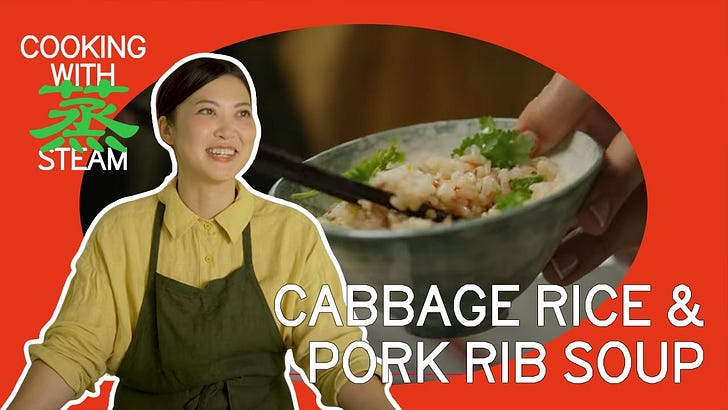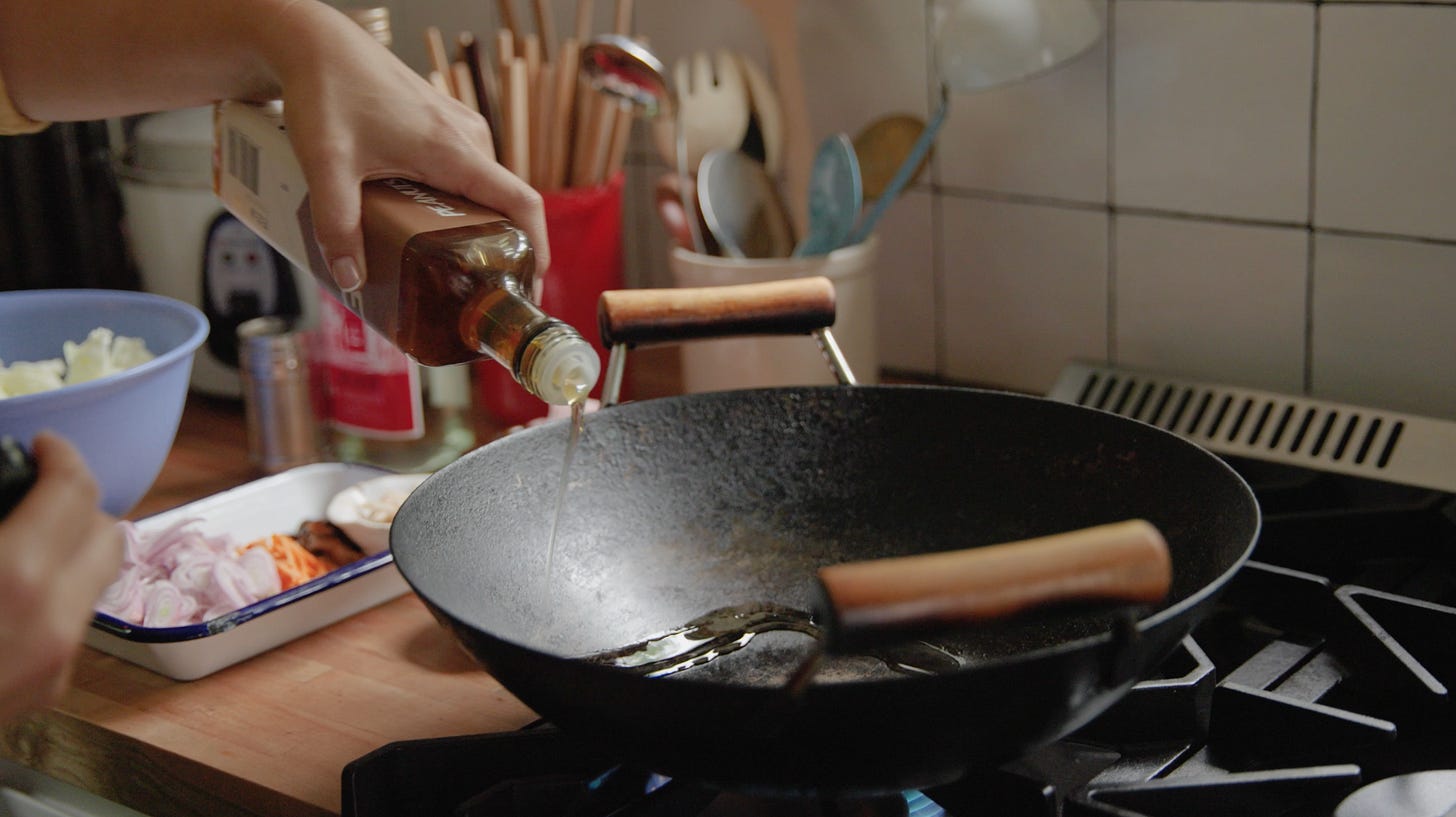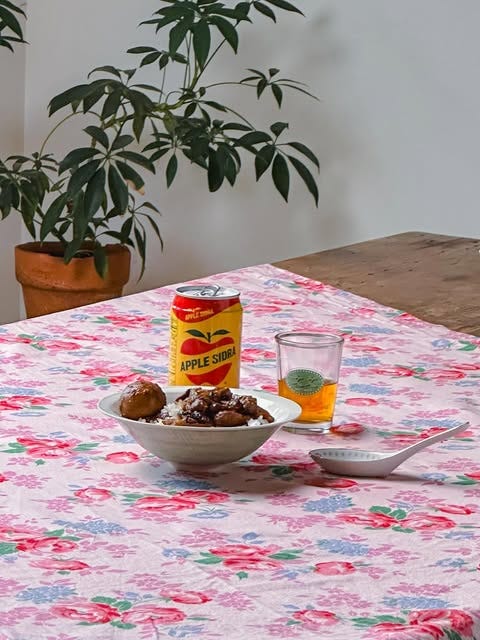Cooking With Steam 好蒸氣 is a cooking show about Taiwanese food. It’s part of Yun Hai Taiwan Stories, a newsletter about Taiwanese food and culture by Lisa Cheng Smith 鄭衍莉, founder of Yun Hai.
Today, I’m excited to share Cabbage Rice and Pork Rib Soup 排骨湯高麗菜飯, the third and final episode from season one of Cooking With Steam. In true “we’re not a network” form, our timelines on this have been a bit unpredictable as we’ve woven our way around tariffs, personnel changes, an office move, and very intense times (to say the absolute least).
I was unable to march in the No Kings protests this past weekend because of a scheduled shoot for the next season of this show, but was very much there in spirit. Seeing images roll in from around the country (and the small town we were filming in) was motivating and inspiring. The second season is imbued with fighting soul.
I value the opportunity to share our immigrant food stories, and believe in the power of food to nurture, communicate, and persist. On the other hand, food isn’t everything. We must lift each other up and fight the fight. I’m so grateful to our team for sharing their talents and focus with us during this moment, and to all the demonstrators giving voice to those who couldn’t be there.
The cabbage rice and pork rib soup combination is one of my favorite Taiwanese food pairings, and this installment shows just how easy it is to have it ready. Tropical Storm Debby (yes this was made in August of 2024) crashes into the episode like the hurricane she was, but we managed to churn out a high CP value pot of cabbage rice anyway. Not pictured: the crew descending on it like hawks and polishing off every last bit in the failing light of day.
It’s hard to believe that we first shot Cooking With Steam almost a year ago. We’ve already wrapped season two, and have prepared five new episodes for release later this year. Read on for the new ep and scroll all the way to the end for a sneak peek at what’s next.
Oh and also, the time has come. We’re discontinuing free shipping as early as Monday, and replacing it with a flat rate (still affordable) option. We’ve held off on this as long as possible, but with 10% minimum tariffs hitting our incoming shipments, we need to adjust to survive. One more weekend to shop with free shipping on orders over $100, please take advantage!
The first season of Cooking With Steam focuses entirely on the Tatung—an electric steamer and rice cooker that is the beating heart of my Taiwanese-American kitchen—and all the different things you can make with it. In this episode, I make Cabbage Rice and Pork Rib Soup 排骨湯高麗菜飯, a pairing very often served together, and one of the oldest Taiwanese set menus I know of.
I think this ep might be my favorite of the three, because I get to improvise on the fly, my natural state of being:
COOKING WITH STEAM Episode 03
Cabbage Rice and Pork Rib Soup
好蒸氣 03 | 排骨湯高麗菜飯
A Brief Introduction to Cabbage Rice
@al.dente.life interviews chefs, bartenders, baristas, and others in the food and beverage industry in Taiwan about where they like to eat after service, grab coffee, dine solo, go on dates, etc. I was reminded of this classic combination when watching his videos, where celebrated Taiwanese chefs so often refer to the pairing as a comfort food.
This dish has its roots in the agrarian communities of Taiwan, and is in the category of recipes sometimes referred to as salty rice, or xian fan 鹹飯. These are savory one-pot meals where rice is seasoned and steamed with proteins and vegetables. Other examples include Shanghai cai fan and Fujian salted rice.
When preparing for this episode, I came across a News & Market article about the dish’s origins in Taiwan. They quoted Hang Yongyuan, village chief of Dakeng 大坑 in southern Taiwan, on the tradition (translated):
Over a hundred years ago, people made their living through farming. During harvest time, the entire village would work together, and the host families would cook salty rice to thank the villagers who helped voluntarily.
According to Yongyuan, people would carry shoulder poles with a vat of cabbage rice on one side and the equally heavy pork rib soup on the other. I thought this was a poetic origin for this classic pairing: balanced not only in flavor and presentation, but also weight. You can’t have one without the other.
Both pork rib soup and cabbage rice can be made in the Tatung steamer, though if you only have one Tatung (yes, admitting I have two), I’d make pork rib soup on the stove, reserving the rice cooker for the… rice.

Featured Recipes
Here are the recipes featured in the episode. I’ve tested them all in my home kitchen, though my demonstration in the video may vary slightly (I tend to drift on set).
Pork Rib Soup 排骨湯
serves 4
Making this in the Tatung Electric Steamer will ensure the soup never comes to a rolling boil, which will keep the broth crystal clear. If making this on the stove, be sure to mind the heat. Don’t skip blanching the ribs, as this step will give you the cleanest, freshest flavor.
Ingredients
1/2 lb pork spare ribs, blanched and rinsed
1 daikon radish (about 1:1 with pork rib)
4-6 slices ginger, to taste (peeling optional)
1 tsp salt (I use Frost Salt)
1/4 tsp white pepper
Water, as needed
for the garnish
1 bunch cilantro, chopped
equipment
Pot
Strainer
Tatung Electric Steamer (6- or 11-cup size; I used the 11-cup for this recipe)
Instructions
First, blanch the pork spare ribs. Place them in a pot with cold water, then bring to a boil. This could also be done in the Tatung: just place them in the inner pot, cover with cold water, and steam for about 10-15 minutes (1/2 rice cup of water). Then, strain them out and rinse them off, rubbing them clean to ensure a clear soup. Set aside.
Peel then cut the daikon. Cut it in half vertically, then slice perpendicularly into half-moon-shaped pieces, about 1/2” inch thick.
Add the pork spare ribs, daikon, and ginger slices into the inner pot of the Tatung. Sprinkle in the salt and the white pepper. Cover with water.
Place the inner pot into the Tatung, then pour 2 rice cups of water into the outer pot. Steam away.
When the switch pops, open the lid and taste for seasoning. If needed, add more salt and white pepper.
To serve, ladle the soup into a bowl, garnish with cilantro, and drizzle with white sesame oil.
Cabbage Rice 高麗菜飯
serves 4
I intended to make this in the Tatung for the episode, but because of the power outage, I couldn’t demonstrate it. So, I improvised a “fake Tatung” on set with an inner pot, a wok, and a bamboo steamer. This is not necessary unless you find yourself in need of a mock-appliance for a Tatung-centered cooking show with no electricity and quickly depleting camera batteries.
But, if you do want to work on the stove, you could steam the rice in a similar way that I did, by putting a rack in the bottom of a deep pan and placing a ceramic or metal bowl on top of it with the rice, cabbage mixture, and water inside. Just make sure you are able to fully cover the pot with a lid.
Ingredients
1/2 head Taiwan flat cabbage
5 dried shiitake mushrooms, cold-soaked overnight or hot-soaked for 30 minutes
1 carrot
2 medium-sized shallots (or 5 small shallots)
1 tbsp dried paper shrimp, cold-soaked overnight and drained
1/2 lb pork belly, par-frozen for 30 minutes to make it easier to slice
2 tbsp peanut oil
1 1/2 tsp salt (I use Frost Salt)
1 tsp white pepper
1/4 cup Taiwanese rice wine
2 rice cups short-grain rice (I use Taiwanese penglai rice)
for the garnish
1 handful cilantro, chopped
equipment
Wok
Tatung Electric Steamer (6- or 11-cup size; I use the 6-cup for this recipe)
Instructions
Prep the vegetables. Squeeze the water out of the reconstituted shiitake mushrooms, then slice them.
Peel and julienne the carrot. I find that the easiest way to do this is to slice the carrot along the diagonal, stack the slices, then finely cut them into matchsticks.
Hand-tear half a head of Taiwan flat cabbage into half-palm sized pieces.
Halve, peel, then thinly slice the shallots.
Cut the pork belly into bite-sized pieces, about 1/2” thick.
In a heated wok over high heat, pour about 2 tbsp of peanut oil. Once the oil is hot, add the shallots and stir-fry until they start to release their water and smell fragrant.
Add the shrimp and the shiitake mushrooms. Toss and cook until the ingredients have caramelized just a touch.
Push the aromatics to the edges of the wok, then add the pork belly to the center. Stir-fry the pork until it begins to brown.
Deglaze the wok with about 1/4 cup Taiwanese rice wine.
Add the carrots then toss.
Sprinkle in the salt and pour in the Soy Paste with Glutinous Rice. Toss.
Sprinkle in the white pepper then toss.
Add the torn cabbage then toss. Cook until the cabbage just begins to wilt and release its water, about a minute. It’s important that the cabbage does not lose its crunch. It will continue to cook in the steamer later on in the recipe.
Taste for saltiness—you want the mixture to taste just a bit too salty, as we will mix it with rice. If you’re satisfied with the salinity, take the mixture off the heat and reserve 1/3 of it for later.
Wash and drain 2 rice cups of short-grain rice into the Tatung inner pot. Add 2/3 of the stir-fried cabbage mixture into the inner pot, on top of the rice. Add scant two rice cups of water into the inner pot.
Place the inner pot into the Tatung, then pour 1 rice cup of water into the outer pot. Steam away! On the stove, this would equate to about 25 minutes of cook time.
Once the switch pops, let rest for 15 minutes. Open, test for doneness, then stir in the reserved 1/3 cabbage mixture.
Add 1/2 rice cup of water to the outer pot and steam to heat everything up.
Scoop into a bowl and serve garnished with cilantro.
Ingredients and Equipment
For the recipes, I use the 11-cup Tatung Steamer to make the pork rib soup, and the 6-cup Tatung Steamer for the cabbage rice. To chop, I’m using our Maestro Wu Vegetable Cleaver on a round ironwood cutting board.
I’m also demonstrating how to use a few Yun Hai products, such as dried shiitake mushrooms, penglai rice, and Soy Paste with Glutinous Rice Grains.
The blue and white curtain in the background is by Li Hsien Hua, who made a similar curtain for our store. The carbon steel wok I used is from The Wok Shop.
The dark brown, green, white, and speckled blue bowls for the tasting of the pork rib soup and cabbage rice were made by my friend Matthew So.
Gratitude and Acknowledgements
We couldn’t have done this without the support and passion of our friends and community. So much love and gratitude to Night Shift, who produced this, and all our creative collaborators for giving the show its unique voice.
Credits
Produced by Night Shift and Yun Hai
Made possible by Tatung Taiwan
Team:
Lisa Cheng Smith, host
Amalissa Uytingco, culinary producer
Sam Broscoe, producer
Alec Sutherland, director & editor
Nathan Bailey, director of photography
Bryan Bonilla, camera operator
Naomi Munro, production designer
Alexandra Egan, art director
Kyle Garvey, sound mixer
Rebecca Alexander, hair and makeup
Dustin Wong, music
O.OO, graphics
Jil Tai & Ben Hill, motion design and title sequence
R. Hollis Smith, mix
Our Set
Our set features props from Taiwanese, Taiwanese-American, and international friends worldwide, creating those Taiwancore vibes we love so much at Yun Hai.
Thank you for the beauty Mikey Chen, Lillian Li, Emilie Liu, Debbie Carlos, Matthew So, Kelli Cain, Material Kitchen, Mogutable, Felicia Liang, Sam Tilney, Lulu Yao Gioiello, Grace Jung, Eric Sze, Julianne Ahn, James Smith, CS Agnes Cheng, and Leh Lin.
Special Thanks
Russell Wang, Maggie Chang, Shirley Liu, Ivan Wu, Feng Hsieh, Hollow, Chris, Leon, Simon, Lillian Lin, Jasmine Huang, Natya Regensburger, Cat Yeh & the entire Yun Hai Team, our partners, and our wonderful community.
Season Two: Gu Zao Wei 古早味

I’m going to save most of the PRECIOUS, CHARMING, TEAR-JERKING, HEART-WARMING, GIGGLE-INDUCING behind-the-scenes images from our most recent shoot in the Catskills for the premiere of the next season, but I just want to say that I came away from it feeling so warm, fuzzy, and cared for. I can’t think of a more compassionate team, from being generous with each other to intently focusing on telling our food stories with respect and integrity. We worked very hard and had a rip roaring good time, too.

Season two expands from centering on the Tatung to addressing Taiwanese food in general. We didn’t always cook with steam on set, but approached the phrase as an idea: a metaphor for a gentle, warm, easy approach to cooking.
Our theme for the season is Gu Zao Wei 古早味, which translates to old school Taiwanese flavor. The five recipes we feature point back to Taiwan’s pre-war, agrarian society, using ingredients that are easily produced on Taiwanese soil, over imported items like wheat and beef. The recipes are… well, you’ll have to wait to find out.
We’re continuously trying to add more Taiwanese voices to the mix, and I was so happy to welcome Jess Wang of Gu Grocery and Jessie YuChen as guests, each starring in a respective episode. Razzing me, too.
More BTS in the Instagram post below:
At Yun Hai, we’ve chosen a path where we take the resources we have (spare as they may be, sometimes) and spend it on projects like this, where we can work with friends and collaborators intent on making original work that adds to the cultural conversation. We’re lucky that because of the enthusiasm of our readers, who share what we’re doing with friends and family, we don’t need to spend heavily on performance advertising as of yet, and are able to produce this ourselves instead.
I’m feeling blessed with the generosity, supportiveness, and talent of our Yun Hai team, collaborators at Night Shift, friends in the community and industry, and you, our readers.
And finally, I want to thank our paid subscribers. We don’t offer much beyond the monthly subscriber-only issue, because we try to keep as much information free as possible, but your funding has gone a long way to keeping this production independent and viable. Thank you so much for your support, and I’ll be working on the next edition of Studio Notes very soon.
Your resident steampunk,
Lisa Cheng Smith 鄭衍莉
Written with research and editorial support by Amalissa Uytingco. If you enjoyed this newsletter, please share it with friends and subscribe if you haven’t already. I email once a month, sometimes more, sometimes less. For more Taiwanese food, head to yunhai.shop, follow us on instagram and twitter, or view the newsletter archives.
About the Tatung
If you’re new to the Tatung, be sure to check out the intro episode, which provides a quick tour, and our newest how-to-make-rice episode, which breaks down how to steam rice in the Tatung:
And if you haven’t seen them yet, check out the first episode, in which I make a simple breakfast featuring Steamed Eggs, as well as the second episode, in which I employ a kitchen tape hack to make Red-Braised Beef Noodle Soup. Find them all in this YouTube playlist.









This looks so good! I can’t wait to make it!! I love the cooking with steam series. Please keep it going!